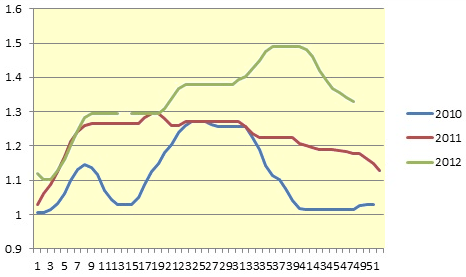



Spanish Hog Markets
SPAIN - Traditionally, the end of the year heralds a decrease in pork prices in the Spanish Market, writes Javier Santamartina - Spain, Italy & Portugal Genesus Representative.After exceptional summer prices, the market has seen a decrease in prices from 1,49 to 1,28 €/kg ($0.89 to $0.75 USD/lb) live weight and it not clear as of yet how far it will fall. The last two years has a decrease of 17 Cents €/kg & 23 Cents €/kg ($0.10 USD & $0.14 USD/lb) respectively, with a decrease of 17 Cents €/kg ($0.10 USD/lb) in 2009. One thing to keep in mind is the Autumn start price was 20 Cents €/kg ($0.12 USD/lb)higher than previous years.
| Genesus Global Market Report Prices for the week of July 16, 2012 |
||
|---|---|---|
| Country | Domestic price (own currency) |
US dollars (Liveweight a lb) |
| USA (Iowa-Minnesota) | 77.03¢ USD/lb carcass | 62.66¢ |
| Canada (Ontario) | 1.41¢ CAD/kg carcass | 51.99¢ |
| Mexico (DF) | 22.70 MXN/kg liveweight | 81.59¢ |
| Brazil (South Region) | 3.28 BRL/kg liveweight | 71.32¢ |
| Russia | 78 RUB/kg liveweight | $1.13 |
| China | 15.35 RMB/kg liveweight | $1.15 |
| Spain | 1.34 EUR/kg liveweight | 78.72¢ |
| Vietnam | 39,500 VND/kg liveweight | 80.58¢ |
| South Korea | 3,900 KRW/kg liveweight | $1.68 |
After a good summer of pig prices, the offer of pigs grows and carcass weight increases. The autumn temperature has allowed good pig growth thereby increasing the pig offer, however on the other side the demand has decreased for 2 main reasons:
- The exports to countries like Russia and China have not managed to support the expected levels. There are several factors impacting the exports. Import prices are low in these two countries and there is a difficulty in competing with other export countries like the US who have lower prices and with better exchange rates. Import levels in these two countries are lower this year as compared to the same two month period in 2011.
- Excess pork production must be sent to other countries in the EU and the general crisis atmosphere of the European Union has put more pressure on the pricing. Generally speaking there is a decrease in all meat consumption with vegetable protein derivatives being cheaper. Slaughter houses can sell their pork but they must lower the price in order to remain competitive. In Germany the price must be lowered 5 cent € /kg ($0.03/lbUSD/lb) to make it attractive to the market.
Pig Price Evolution

Other factors such as the high price of raw materials, soya (record high prices) and grains.
| Soya 480 €/ton ($17.06 USD/Bushel) |
Corn 260 €/ton ($8.63 USD / Bushel) |
Wheat 270 €/ton ($9.61 USD / Bushel) |
These prices will remain high until the next harvest. This global situation will have consequences, mainly in the reduction of margins. This situation is more critical in market with less financial capacity like the South of Europe. Producers have more difficulty accessing bank credit. At the beginning of the year farms must adopt welfare rules in order to survive. The result of all these factors combining are a reduction in the number of farms and hence a reduction in total sows in production. Some farms are reducing the number of sows while others are changing from sow production to fattening.
In summary, decreases in pork prices are according to expectations based on last year’s prices, with high production costs impacting the market here as well as in the rest of the world.







